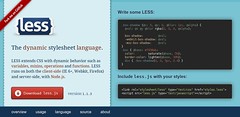LESS hubris, more humility

For CSS hacks like myself, there are a couple of "CSS preprocessors" out in the wild which can make your life much, much easier. They allow a mere non-programmer front end developer mortals to use variables (gasp), mixins (what?) and functions (horror!). Your super-lean styles are then processed into plain CSS for browsers.
The first one I looked at was SaSS, which uses elegant Ruby to do the processing. This made sense, as I was working on a Ruby on Rails project, and I had read the excellent post extolling its virtues by the ever-informative Nathan Smith.
And then the Winds of Change did their changing thing, and I was on a Drupal project, with no Ruby in sight.
Fortuitously, the right-talented web-designer bastard Andy Clarke (aka Malarkey) wrote a post about LESS, a JavaScript powered CSS preprocessor. The beauty of LESS from my perspective is that it can run in the browser or on the server, which makes it way easier to setup. a
I have LESS working now, straight out of the box (although Chrome doesn't like it being run locally for some reason), and will be using it for my next Project, codenamed 'One With Everything: How Many Technologies Can You Stuff In One Website?'. Heck, I might even dabble with installing it on the server.
What marks out Malarkey, apart from the generosity of sharing his experience, bountiful opinions and his mobile 320 and Up framework, is that he knows how to say sorry:
“I once wrote that there was no need to use a CSS pre-processor like LESS or Sass. I was wrong. Very sorry.“
